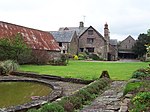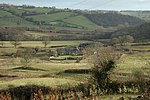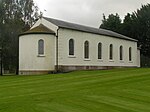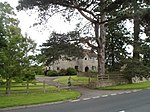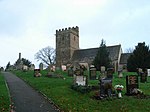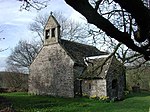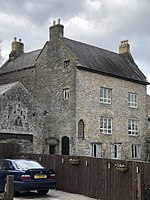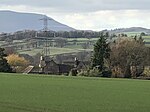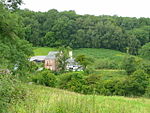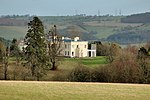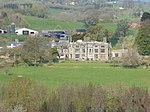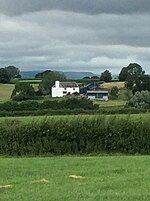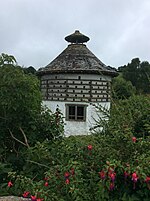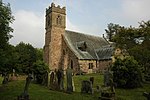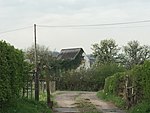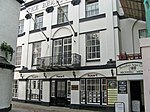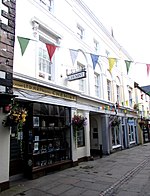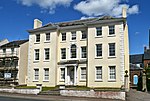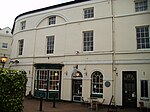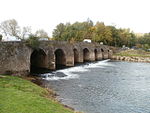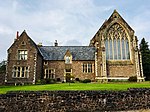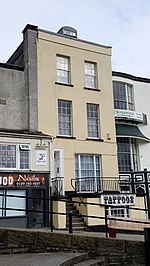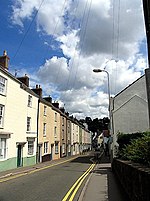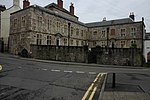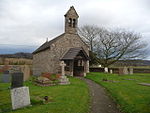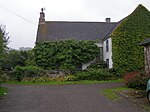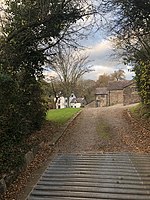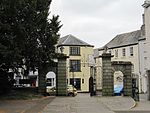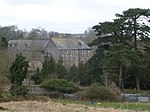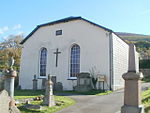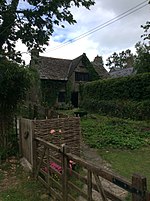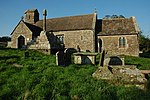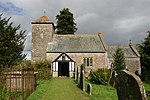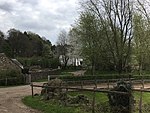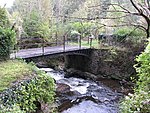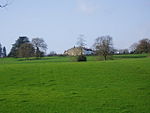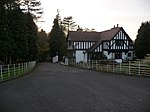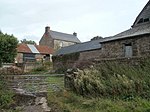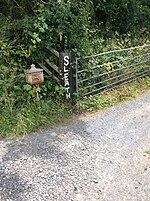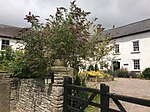Name Location Date Listed Grid Ref. [note 4] Function Notes Reference Number Image Upper Dyffryn House Grosmont 5 June 1952 SO4218223413 51°54′23″N 2°50′31″W / 51.906265200146°N 2.8418471632412°W / 51.906265200146; -2.8418471632412 (Upper Dyffryn House ) House On the road to Norton, 2 km (1.2 mi) south-east of Grosmont. The detached kitchen and dairy building has a separate Grade II* listing.[50] [51] 1922 Old Court Llangattock Lingoed 5 June 1952 SO3616719492 51°52′13″N 2°55′43″W / 51.87036°N 2.92854°W / 51.87036; -2.92854 (Old Court ) House 1 km (0.62 mi) south of Llangattock Lingoed on the road to Llanvetherine[52] 1923 Great Pool Hall Llanvetherine 5 June 1952 SO3713618970 51°51′57″N 2°54′52″W / 51.86578°N 2.91437°W / 51.86578; -2.91437 (Great Pool Hall ) House 2 km (1.2 mi) north-east of Llanvetherine[53] 1924 Llanarth Court Llanarth 5 June 1952 SO3806110470 51°47′22″N 2°53′58″W / 51.789466234942°N 2.8994188030168°W / 51.789466234942; -2.8994188030168 (Llanarth Court ) House South-east of Llanarth[54] 1925 Wern-ddu Farmhouse Llantilio Pertholey 5 June 1952 SO3207715270 51°49′55″N 2°59′14″W / 51.831920493182°N 2.9871059647435°W / 51.831920493182; -2.9871059647435 (Wern-ddu Farmhouse ) Farmhouse On the road to Skenfrith 500 m (1,600 ft) east of Maindiff Court Hospital[55] 1927 Court Farmhouse Llanover 5 June 1952 SO3543713100 51°48′46″N 2°56′17″W / 51.812812046985°N 2.9379476438151°W / 51.812812046985; -2.9379476438151 (Court Farmhouse ) Farmhouse 1 km (0.62 mi) north of Llanover village on the road to the church[56] 1928 Trewyn House Llanvihangel Crucorney 1 September 1956 SO3287222846 51°54′00″N 2°58′37″W / 51.90012°N 2.97705°W / 51.90012; -2.97705 (Trewyn House ) House Manor house dating from 1692, 2 km (1.2 mi) north of the village of Llanvihangel Crucorney[57] 1931 Trewyn House Dovecote Llanvihangel Crucorney 1 September 1956 SO3290622919 51°54′03″N 2°58′36″W / 51.900782208216°N 2.9765658893335°W / 51.900782208216; -2.9765658893335 (Trewyn House Dovecote ) Dovecote 50 m (160 ft) north of Trewyn House[58] 1932 Little Llwygy Farmhouse Cwmyoy 1 September 1956 SO3172322091 51°53′35″N 2°59′37″W / 51.89319°N 2.99359°W / 51.89319; -2.99359 (Little Llwygy Farmhouse ) Farmhouse At the south end of Lower Cwmyoy[59] 1936 Llanvihangel Court Garden House Llanvihangel Crucorney 1 September 1956 SO3288820384 51°52′41″N 2°58′35″W / 51.877991539428°N 2.9763333739119°W / 51.877991539428; -2.9763333739119 (Llanvihangel Court Garden House ) Garden structure In the grounds of Llanvihangel Court[60] 1945 Lower Duffryn House Grosmont 1 September 1956 SO4351822730 51°54′01″N 2°49′20″W / 51.900262464362°N 2.82231725887°W / 51.900262464362; -2.82231725887 (Lower Duffryn House ) House 3 km (1.9 mi) southwest of Grosmont, off the road to Norton[61] 1950 Glyndŵr House Grosmont 1 September 1956 SO4041024416 51°54′54″N 2°52′04″W / 51.915094813107°N 2.8677754216991°W / 51.915094813107; -2.8677754216991 (Glyndŵr House ) House In the centre of Grosmont, 50 m (160 ft) north-west of the town hall[62] 1952 Town Farm Grosmont 1 September 1956 SO4042824338 51°54′52″N 2°52′03″W / 51.914395540103°N 2.8675002392862°W / 51.914395540103; -2.8675002392862 (Town Farm ) Farmhouse 50 m (160 ft) north-west of the church in the centre of Grosmont[63] 1953 Lower Tresenny Barn Grosmont 1 September 1956 SO4085424071 51°54′43″N 2°51′41″W / 51.912040769107°N 2.8612616566307°W / 51.912040769107; -2.8612616566307 (Lower Tresenny Barn ) Barn 400 m (1,300 ft) south-east of Grosmont[64] 1954 Church of St James Llangua 1 September 1956 SO3896725743 51°55′37″N 2°53′20″W / 51.92687°N 2.88899°W / 51.92687; -2.88899 (Church of St James ) Church 15th century church 1 km (0.62 mi) south-west of Llangua Bridge[65] 1958 Lower Celliau Llangattock Lingoed 1 September 1956 SO3720921018 51°53′03″N 2°54′49″W / 51.88419°N 2.91369°W / 51.88419; -2.91369 (Lower Celliau ) House Early 16th century cruck framed hall house 1 km (0.62 mi) north-east of Llangattock Lingoed[66] 1960 Church of Saint Peter Bryngwyn 1 September 1956 SO3905409322 51°46′45″N 2°53′05″W / 51.77925508479°N 2.8848218471944°W / 51.77925508479; -2.8848218471944 (Church of Saint Peter ) Church In Bryngwyn, 500 m (1,600 ft) north of the junction with the old A40 [67] 1964 Chapel Farmhouse Llanarth 1 September 1956 SO3686009399 51°46′47″N 2°55′00″W / 51.779703539759°N 2.9166336746531°W / 51.779703539759; -2.9166336746531 (Chapel Farmhouse ) Farmhouse To the north of Clytha Park[68] 1965 Clytha Park, gateway and railings Llanarth 1 September 1956 SO3633308852 51°46′29″N 2°55′27″W / 51.774726253576°N 2.9241710772689°W / 51.774726253576; -2.9241710772689 (Clytha Park, gateway and railings ) Walls, railings, gates At the entrance to Clytha Park, on the old A40 [69] 1967 Church of Saint Teilo Llanarth 1 September 1956 SO3756410961 51°47′38″N 2°54′24″W / 51.793824895949°N 2.9067120353486°W / 51.793824895949; -2.9067120353486 (Church of Saint Teilo ) Church At the southern end of Llanarth in a large churchyard[70] 1969 Church of St Mary and St Michael Llanarth 1 September 1956 SO3806010520 51°47′24″N 2°53′58″W / 51.78991°N 2.89944°W / 51.78991; -2.89944 (Church of St Mary and St Michael ) Church North of Llanarth Court[71] 1971 Little Pitt Cottage Llanarth 1 September 1956 SO3689109916 51°47′04″N 2°54′59″W / 51.784354805232°N 2.9162785644656°W / 51.784354805232; -2.9162785644656 (Little Pitt Cottage ) House On the north side of the road from Llanarth to the old A40 300 m (980 ft) west of Pitt village[72] 1974 Church of Saint Mapley Llanvapley 1 September 1956 SO3667914088 51°49′19″N 2°55′12″W / 51.821836354728°N 2.9201149018994°W / 51.821836354728; -2.9201149018994 (Church of Saint Mapley ) Church To the east of Llanvapley[73] 1976 Llanwenarth House Llanfoist 1 September 1956 SO2587713973 51°49′10″N 3°04′36″W / 51.819471376304°N 3.0767856272697°W / 51.819471376304; -3.0767856272697 (Llanwenarth House ) Commercial In its park south of the Monmouthshire and Brecon Canal, with a drive from the B4246 [74] 1977 Church of St Peter Llanwenarth 1 September 1956 SO2756514812 51°49′38″N 3°03′09″W / 51.82724°N 3.05248°W / 51.82724; -3.05248 (Church of St Peter ) Church South of the A40 [75] 1980 Church of St Cadoc Llangattock-juxta-Usk 1 September 1956 SO3303209647 51°46′53″N 2°58′20″W / 51.781487060037°N 2.9721608218467°W / 51.781487060037; -2.9721608218467 (Church of St Cadoc ) Church By the River Usk and the railway line to the south-west of The Bryn[76] 1988 Llangattock Court Penpergwm 1 September 1956 SO3328110262 51°47′13″N 2°58′07″W / 51.787045548392°N 2.9686703726559°W / 51.787045548392; -2.9686703726559 (Llangattock Court ) House On the B4598 200 m (660 ft) west of the former King of Prussia pub[77] 1990 Church of St Bartholomew Llanover 1 September 1956 SO3179509426 51°46′46″N 2°59′24″W / 51.779350627234°N 2.9900457406724°W / 51.779350627234; -2.9900457406724 (Church of St Bartholomew ) Church 1.2 km (0.75 mi) north of Llanover by the River Usk, on the road from Llanellen to Llanfair Kilgeddin[78] 1992 Church of St Michael Llanvihangel Gobion 1 September 1956 SO3460809228 51°46′40″N 2°56′57″W / 51.77791°N 2.94924°W / 51.77791; -2.94924 (Church of St Michael ) Church 250 m (820 ft) to the south-west of the village road off the B4598 [79] 1998 Blaengavenny Farmhouse Llanvihangel Crucorney 1 September 1956 SO3111319653 51°52′16″N 3°00′07″W / 51.871203330019°N 3.0019681212727°W / 51.871203330019; -3.0019681212727 (Blaengavenny Farmhouse ) Farmhouse On the old Abergavenny-Hereford road halfway between Llanvihangel Crucorney and Pantygelli[80] 2003 Moynes Court Mathern 10 June 1953 ST5198190937 51°36′55″N 2°41′42″W / 51.615226569949°N 2.6949241046111°W / 51.615226569949; -2.6949241046111 (Moynes Court ) House 300 m (980 ft) west of the church on a lane off the road through Mathern south of the M48 [81] 2008 St Pierre Hotel Gatehouse Mathern 10 June 1953 ST5150690573 51°36′43″N 2°42′06″W / 51.611913164832°N 2.7017333378221°W / 51.611913164832; -2.7017333378221 (St Pierre Hotel Gatehouse ) Gatehouse The main gateway to the St Pierre Hotel[82] 2010 Piercefield House St Arvans 4 August 1970 ST5281095680 51°39′29″N 2°41′01″W / 51.657939286602°N 2.6835931007269°W / 51.657939286602; -2.6835931007269 (Piercefield House ) House 1 km (0.62 mi) to the north-east of the roundabout at the A466 /B4293 crossing; the central block and the West and East pavilions each have separate listings[83] [84] [85] 2013 Church of St Stephen and St Tathan Caerwent 19 August 1955 ST4687190485 51°36′39″N 2°46′07″W / 51.610702631716°N 2.7686506974347°W / 51.610702631716; -2.7686506974347 (Church of St Stephen and St Tathan ) Church In the centre of Caerwent[86] 2014 Church of St Michael Llanfihangel Tor-y-Mynydd 19 August 1955 SO4639501856 51°42′46″N 2°46′38″W / 51.71289°N 2.77727°W / 51.71289; -2.77727 (Church of St Michael ) Church In Llanfihangel Tor-y-Mynydd, and of the late 15th century, with a two-light bell-cot [87] 2020 Church of St Thomas à Becket Wolvesnewton 19 August 1955 ST4542099770 51°41′39″N 2°47′28″W / 51.69404°N 2.79106°W / 51.69404; -2.79106 (Church of St Thomas à Becket ) Church In the centre of Wolvesnewton[88] 2023 Church of St Thomas a Becket, churchyard cross Wolvesnewton 19 August 1955 ST4542799752 51°41′38″N 2°47′27″W / 51.693877866688°N 2.7909510484154°W / 51.693877866688; -2.7909510484154 (Church of St Thomas a Becket, churchyard cross ) Cross 15 m (49 ft) south of the church[89] 2024 Church of the Holy Cross Kilgwrrwg 19 August 1955 ST4621798451 51°40′56″N 2°46′46″W / 51.68226°N 2.77932°W / 51.68226; -2.77932 (Church of the Holy Cross ) Church 500 m (1,600 ft) north of Kilgwrrwg House[90] 2025 Allt-y-Bela Llangwm 19 August 1955 SO4110400576 51°42′03″N 2°51′13″W / 51.700847818936°N 2.8536272088685°W / 51.700847818936; -2.8536272088685 (Allt-y-Bela ) House 1 km (0.62 mi) from the junction east of Llangeview church[91] 2031 Cwrt y Brychan barn, stable and granary Llangwm 19 August 1955 SO4494401526 51°42′35″N 2°47′54″W / 51.709779326385°N 2.7982189219026°W / 51.709779326385; -2.7982189219026 (Cwrt y Brychan barn, stable and granary ) Farm buildings East of Cwrt y Brychan[92] 2033 Church of St Michael and All Angels Llanfihangel Rogiet 19 August 1955 ST4511987861 51°35′13″N 2°47′37″W / 51.58694°N 2.79354°W / 51.58694; -2.79354 (Church of St Michael and All Angels ) Church South of the Caldicot Road[93] 2035 Manor Farmhouse Crick 19 August 1955 ST4902990257 51°36′32″N 2°44′15″W / 51.60885°N 2.73746°W / 51.60885; -2.73746 (Manor Farmhouse ) Farmhouse On the A48 at the east end of Crick[94] 2038 Moynes Court Gatehouse Mathern 19 August 1955 ST5201090964 51°36′56″N 2°41′40″W / 51.61547°N 2.69451°W / 51.61547; -2.69451 (Moynes Court Gatehouse ) House Dating from the 14th century, 250 m (820 ft) west of the church[95] 2042 Church of St Mary Rogiet 19 August 1955 ST4566387647 51°35′06″N 2°47′08″W / 51.58507°N 2.78565°W / 51.58507; -2.78565 (Church of St Mary ) Church To the west of the village[96] 2047 Howick Farmhouse Itton 19 August 1955 ST5022795567 51°39′24″N 2°43′15″W / 51.65670°N 2.72091°W / 51.65670; -2.72091 (Howick Farmhouse ) Farmhouse 16th century house 500 m (1,600 ft) north-east of the B4293[97] 2049 St Anne's House Tintern 19 August 1955 ST5318799956 51°41′47″N 2°40′43″W / 51.696414482174°N 2.6787181811921°W / 51.696414482174; -2.6787181811921 (St Anne's House ) House At the junction of the A466 and Chapel Lane 200 m (660 ft) east of the abbey[98] 2051 Church Farmhouse Caldicot 5 July 1973 ST4823788820 51°35′45″N 2°44′55″W / 51.595860967065°N 2.7486794629968°W / 51.595860967065; -2.7486794629968 (Church Farmhouse ) Farmhouse 200 m (660 ft) north of the church off Church Road, surrounded by a modern housing estate[99] 2055 Great Killough Llantilio Crossenny 5 January 1952 SO3823213986 51°49′16″N 2°53′51″W / 51.821093595094°N 2.8975676695316°W / 51.821093595094; -2.8975676695316 (Great Killough ) House 2 km (1.2 mi) south-west of the church[100] 2056 The Pant Llanvihangel-Ystern-Llewern 5 January 1952 SO4234614045 51°49′19″N 2°50′16″W / 51.82206°N 2.83790°W / 51.82206; -2.83790 (The Pant ) House A 16th century cruck framed hall house between Onen and Wernrheolydd[101] 2057 Trivor Farmhouse St Maughans 5 January 1952 SO4649117731 51°51′20″N 2°46′42″W / 51.85562°N 2.77834°W / 51.85562; -2.77834 (Trivor Farmhouse ) Farmhouse Dating from 1630, north-east of the church[102] 2058 Hilston Park Llangattock Vibon Avel 5 January 1952 SO4466418748 51°51′52″N 2°48′18″W / 51.864579640235°N 2.8050232526416°W / 51.864579640235; -2.8050232526416 (Hilston Park ) House 2 km (1.2 mi) south-west of Skenfrith, on the B4347 [103] 2059 Troy House Mitchel Troy 5 January 1952 SO5093511352 51°47′55″N 2°42′46″W / 51.798675965048°N 2.7129102008103°W / 51.798675965048; -2.7129102008103 (Troy House ) House 1.5 km (0.93 mi) south of Monmouth[104] 2060 Dingestow Court Dingestow 5 January 1952 SO4506409715 51°47′00″N 2°47′52″W / 51.783411876656°N 2.797778617519°W / 51.783411876656; -2.797778617519 (Dingestow Court ) House Standing in its own grounds, 1 km (0.62 mi) south-west of the church[105] 2061 Llwyn-y-gaer House Tregare 5 January 1952 SO4046111111 51°47′44″N 2°51′53″W / 51.795489963096°N 2.8647374512734°W / 51.795489963096; -2.8647374512734 (Llwyn-y-gaer House ) House 1.6 km (0.99 mi) north-west of the church on the road between Tregare and Llantilio Crossenny[106] 2062 The Artha Tregare 5 January 1952 SO4232009654 51°46′57″N 2°50′15″W / 51.782586711956°N 2.837541949815°W / 51.782586711956; -2.837541949815 (The Artha ) Farmhouse 800 m (2,600 ft) south of the church on a farm track off the road between Tregare and Dingestow[107] 2063 Old Trecastle Farmhouse Pen-y-clawdd 5 January 1952 SO4516806991 51°45′32″N 2°47′45″W / 51.758932889844°N 2.7958401704515°W / 51.758932889844; -2.7958401704515 (Old Trecastle Farmhouse ) Farmhouse 800 m (2,600 ft) south of church at Penyclawdd[108] 2066 Treworgan Manor Llansoy 5 January 1952 SO4210005081 51°44′29″N 2°50′24″W / 51.741452300833°N 2.8399672003299°W / 51.741452300833; -2.8399672003299 (Treworgan Manor ) House 3 km (1.9 mi) south-east of Raglan on the road to Llansoy[109] 2067 Hygga House Dovecote Trellech 5 January 1952 SO4855803647 51°43′45″N 2°44′46″W / 51.72919171226°N 2.7462331282178°W / 51.72919171226; -2.7462331282178 (Hygga House Dovecote ) Dovecote 500 m (1,600 ft) north-east of the church at Llanishen on a lane off the Chepstow Road, the B4293 [110] 2071 Church of St Michael and All Angels Llanvihangel-Ystern-Llewern 19 November 1953 SO4328113955 51°49′17″N 2°49′28″W / 51.82135°N 2.82432°W / 51.82135; -2.82432 (Church of St Michael and All Angels ) Church Medieval church located in the centre of Llanvihangel-Ystern-Llewern[111] 2072 Brynderi House Llantilio Crossenny 19 November 1953 SO3938417245 51°51′02″N 2°52′53″W / 51.850518012759°N 2.8814281189328°W / 51.850518012759; -2.8814281189328 (Brynderi House ) House 2 km (1.2 mi) north of Llantilio Crossenny, with a driveway off the road from White Castle to Cross Ash[112] 2074 Croft Farm Barn Llantilio Crossenny 19 November 1953 SO3797317833 51°51′20″N 2°54′07″W / 51.855648667364°N 2.9020159066027°W / 51.855648667364; -2.9020159066027 (Croft Farm Barn, Llantilio Crossenny ) Barn 1 km (0.62 mi) north of White Castle, on the road between White Castle and the B4521 [113] 2077 Upper Green Llantilio Crossenny 19 November 1953 SO3874819020 51°51′59″N 2°53′28″W / 51.866405351102°N 2.8909755550137°W / 51.866405351102; -2.8909755550137 (Upper Green ) House 4 km (2.5 mi) north of Llantilio Crossenny, on a track off the B4521 towards Llanfair Green[114] 2078 Skenfrith Castle Skenfrith 19 November 1953 SO4570020262 51°52′42″N 2°47′25″W / 51.878292567865°N 2.7902181881841°W / 51.878292567865; -2.7902181881841 (Skenfrith Castle ) Castle At the southeast corner of Skenfrith, by the River Monnow 100 m (330 ft) north-west of Skenfrith Bridge[115] 2083 Church of St Maughan Llangattock Vibon Avel 19 November 1953 SO4611217162 51°51′02″N 2°47′02″W / 51.85046°N 2.78375°W / 51.85046; -2.78375 (Church of St Maughan ) Church 7 km (4.3 mi) north-west of Monmouth on a lane off the B4347 [116] 2084 Church of St Michael and All Angels Mitchel Troy 19 November 1953 SO4921710399 51°47′24″N 2°44′16″W / 51.78995°N 2.73768°W / 51.78995; -2.73768 (Church of St Michael and All Angels ) Church In the centre of Mitchel Troy on the old road from Monmouth to Raglan[117] 2086 Pwll Tregare 19 November 1953 SO4098109698 51°46′58″N 2°51′25″W / 51.782842330054°N 2.8569573960975°W / 51.782842330054; -2.8569573960975 (Pwll ) House 2 km (1.2 mi) north of Raglan, south-west of the church at Tregare[118] 2090 Ty Mawr Dingestow 19 November 1953 SO4376709959 51°47′08″N 2°49′00″W / 51.785476318133°N 2.8166179585316°W / 51.785476318133; -2.8166179585316 (Ty Mawr ) Farmhouse 2 km (1.2 mi) west of Dingestow church, on the road between Dingestow and Tregare[119] 2092 Ty Mawr Gatehouse Dingestow 19 November 1953 SO4378409929 51°47′07″N 2°48′59″W / 51.785208327446°N 2.8163666662743°W / 51.785208327446; -2.8163666662743 (Ty Mawr Gatehouse ) Gatehouse 2 km (1.2 mi) west of Dingestow church, on the road between Dingestow and Tregare[120] 2093 Pen-y-clawdd Farmhouse Raglan 19 November 1953 SO4395708308 51°46′14″N 2°48′49″W / 51.770652744157°N 2.8135967462009°W / 51.770652744157; -2.8135967462009 (Pen-y-clawdd Farmhouse ) Farmhouse On a farm track off the road from Raglan to Penyclawdd[121] 2099 Church of St Cadoc Raglan 19 November 1953 SO4134007684 51°45′53″N 2°51′05″W / 51.764774232045°N 2.8514129898452°W / 51.764774232045; -2.8514129898452 (Church of St Cadoc ) Church In the centre of the village[122] 2100 Pant-glas Farmhouse Llanishen 19 November 1953 SO4813704110 51°44′00″N 2°45′09″W / 51.733315346938°N 2.7523973506734°W / 51.733315346938; -2.7523973506734 (Pant-glas Farmhouse ) Farmhouse 1.2 km (0.75 mi) to the north-east of the church at Llanishen on a lane from the B4293 [123] 2103 Usk Bridge Usk 4 January 1974 SO3742900734 51°42′07″N 2°54′25″W / 51.701869653565°N 2.9068257463166°W / 51.701869653565; -2.9068257463166 (Usk Bridge ) Bridge Leading out of Usk to the west, carrying the A472 [124] 2129 Sessions House Usk 4 January 1974 SO3783000544 51°42′01″N 2°54′04″W / 51.700206212792°N 2.9009899936509°W / 51.700206212792; -2.9009899936509 (Sessions House ) Courthouse In the south of the town, next to the prison[125] 2154 Usk Prison Usk 4 January 1974 SO3787300460 51°41′58″N 2°54′01″W / 51.699455822204°N 2.9003528838404°W / 51.699455822204; -2.9003528838404 (Usk Prison ) Prison South of the town centre[126] 2155 Ynys Hafod Usk 16 February 1953 SO3755100579 51°42′02″N 2°54′18″W / 51.70049°N 2.90503°W / 51.70049; -2.90503 (Ynys Hafod ) House A range of three 16th century houses, with Henllys and Min Yr Afon, on the west side of New Market Street[127] 2169 Porth-y-carn Usk 4 January 1974 SO3752000990 51°42′15″N 2°54′20″W / 51.704181258532°N 2.9055550855252°W / 51.704181258532; -2.9055550855252 (Porth-y-carn ) House North of the centre of the town with a garden running down to the River Usk[128] 2189 Church of St Thomas the Martyr Monmouth 27 June 1952 SO5044012454 51°48′31″N 2°43′13″W / 51.808539487553°N 2.7202456180308°W / 51.808539487553; -2.7202456180308 (Church of St Thomas the Martyr ) Church To the south of Monnow Bridge, in the suburb of Overmonnow[129] 2214 Church of St Peter Dixton 27 June 1952 SO5196613564 51°49′07″N 2°41′54″W / 51.81865°N 2.69827°W / 51.81865; -2.69827 (Church of St Peter ) Church 1.5 km (0.93 mi) north-east of Monmouth[130] 2215 Clawdd-du Bridge Monmouth 15 August 1974 SO5024912339 51°48′27″N 2°43′23″W / 51.807488599388°N 2.7229991697438°W / 51.807488599388; -2.7229991697438 (Clawdd-du Bridge ) Bridge South-west of St Thomas' Square where it crosses a defensive ditch[131] 2219 Roundhouse at The Kymin Monmouth 27 June 1952 SO5276512498 51°48′33″N 2°41′12″W / 51.80913686387°N 2.6865316162974°W / 51.80913686387; -2.6865316162974 (Roundhouse at The Kymin ) Folly On the eastern side of Monmouth, offering panoramic views[132] 2222 Agincourt House Monmouth 27 June 1952 SO5079912882 51°48′45″N 2°42′54″W / 51.81242°N 2.71510°W / 51.81242; -2.71510 (Agincourt House ) Commercial In Agincourt Square in the centre of the town[133] 2223 Beaufort Arms Hotel Monmouth 27 June 1952 SO5080812840 51°48′43″N 2°42′54″W / 51.81204°N 2.71496°W / 51.81204; -2.71496 (Beaufort Arms Hotel ) Commercial In Agincourt Square in the centre of the town, now converted to shops and apartments[134] 2227 Statue of Charles Rolls Monmouth 15 August 1974 SO5077012846 51°48′44″N 2°42′56″W / 51.81209°N 2.71552°W / 51.81209; -2.71552 (Statue of Charles Rolls ) Statue In Agincourt Square in the centre of the town[135] 2229 Kings Head Hotel Monmouth 27 June 1952 SO5075912810 51°48′42″N 2°42′56″W / 51.811768285239°N 2.7156698194677°W / 51.811768285239; -2.7156698194677 (Kings Head Hotel ) Commercial In Agincourt Square in the centre of the town.[136] Thomas Henry Wyatt now forms part of the hotel.[137] 2230 9 Agincourt Street Monmouth 27 June 1952 SO5080412793 51°48′42″N 2°42′54″W / 51.811619423031°N 2.7150147110208°W / 51.811619423031; -2.7150147110208 (9 Agincourt Street ) Commercial On Agincourt Street running southeast from Agincourt Square[138] 2242 12 Church Street Monmouth 27 October 1965 SO5082312922 51°48′46″N 2°42′53″W / 51.812780844164°N 2.7147574853217°W / 51.812780844164; -2.7147574853217 (12 Church Street ) Commercial On a pedestrianised street running north-east from Agincourt Square in the centre of the town[139] 2253 Glendower House Monmouth 27 October 1965 SO5086012761 51°48′41″N 2°42′51″W / 51.811336672633°N 2.7141979293002°W / 51.811336672633; -2.7141979293002 (Glendower House ) House A neoclassical chapel now converted to a private residence[140] 2272 Royal George House Monmouth 27 June 1952 SO5097713049 51°48′50″N 2°42′45″W / 51.813936171225°N 2.7125418009923°W / 51.813936171225; -2.7125418009923 (Royal George House ) Commercial On a road running north–south on the eastern side of the town[141] 2282 Lord Nelson's Seat Monmouth 27 June 1952 SO5077912728 51°48′40″N 2°42′55″W / 51.811032848958°N 2.7153680592672°W / 51.811032848958; -2.7153680592672 (Lord Nelson's Seat ) Garden structure In the garden of No. 18, Monnow Street, with access from Chippenham Mead[142] 2290 Cornwall House, railings & gates Monmouth 15 August 1974 SO5062712695 51°48′39″N 2°43′03″W / 51.810722731212°N 2.7175679473344°W / 51.810722731212; -2.7175679473344 (Cornwall House, railings & gates ) Walls, railings, gates Fronting Monmouth's main thoroughfare, Monnow Street, which runs from Agincourt Square to the Monnow Bridge [143] 2293 Robin Hood Inn Monmouth 27 June 1952 SO5051212562 51°48′34″N 2°43′09″W / 51.80952°N 2.71922°W / 51.80952; -2.71922 (Robin Hood Inn ) Commercial Fronting Monmouth's main thoroughfare, Monnow Street, which runs from Agincourt Square to the Monnow Bridge[144] 2297 Chapel House Monmouth 27 June 1952 SO5091713213 51°48′55″N 2°42′48″W / 51.81541°N 2.71344°W / 51.81541; -2.71344 (Chapel House ) House On the main road running north from the town centre towards Hereford[145] 2309 Old Nag's Head Monmouth 26 April 1955 SO5112712967 51°48′48″N 2°42′37″W / 51.813212138203°N 2.710354469363°W / 51.813212138203; -2.710354469363 (Old Nag's Head ) Commercial Formed in part from the historical east gate into the town[146] 2312 The Shambles Monmouth 15 August 1974 SO5081612998 51°48′48″N 2°42′54″W / 51.813463487179°N 2.7148698318419°W / 51.813463487179; -2.7148698318419 (The Shambles ) Museum Fronting Priory Street, an early by-pass leading north-east from Agincourt Square[147] 2318 White Swan Inn Monmouth 27 June 1952 SO5080812931 51°48′46″N 2°42′54″W / 51.812860433322°N 2.7149763340807°W / 51.812860433322; -2.7149763340807 (White Swan Inn ) Commercial Formerly an inn, now part of a complex of shops accessible from both Priory Street and Church Street[148] 2321 Monmouth Priory Monmouth 27 June 1952 SO5086813008 51°48′49″N 2°42′51″W / 51.813557974867°N 2.714117006597°W / 51.813557974867; -2.714117006597 (Monmouth Priory ) Community Centre On Priory Street running north-east from Agincourt Square[149] 2323 Monmouth Methodist Church Monmouth 27 June 1952 SO5102312905 51°48′46″N 2°42′43″W / 51.812645614598°N 2.7118541699233°W / 51.812645614598; -2.7118541699233 (Monmouth Methodist Church ) Church On the street running to St James's Square on the eastern side of the town 300 m (980 ft) from the centre[150] 2342 The Tithe Barn Abergavenny 5 July 1952 SO3005114110 51°49′16″N 3°00′59″W / 51.821242086511°N 3.0162675239829°W / 51.821242086511; -3.0162675239829 (The Tithe Barn ) Barn Near the church in the centre of Abergavenny[151] 2375 Abergavenny Bridge Abergavenny /Llanfoist 5 July 1952 SO2915113947 51°49′11″N 3°01′45″W / 51.81966°N 3.02929°W / 51.81966; -3.02929 (Abergavenny Bridge ) Bridge 15th-century bridge crossing the River Usk [152] [153] 2378 Church of Our Lady and St Michael RC Abergavenny 11 January 1974 SO2968214648 51°49′34″N 3°01′18″W / 51.82603204227°N 3.0217297046463°W / 51.82603204227; -3.0217297046463 (Church of Our Lady and St Michael RC ) Church On the north side of the town[154] 2467
St John's Masonic Lodge Abergavenny 5 July 1952 SO2983914198 51°49′19″N 3°01′10″W / 51.822006532919°N 3.0193606713968°W / 51.822006532919; -3.0193606713968 (St John's Masonic Lodge ) Masonic Lodge In the centre of town to the west of the High Street[155] 2470 Raglan Lodge Chepstow 30 April 1956 ST5336093934 51°38′32″N 2°40′31″W / 51.642287737301°N 2.6754093418336°W / 51.642287737301; -2.6754093418336 (Raglan Lodge ) House In Beaufort Square[156] 2501 14 Beaufort Square Chepstow 6 December 1950 ST5336693922 51°38′32″N 2°40′31″W / 51.642180348908°N 2.675321037383°W / 51.642180348908; -2.675321037383 (14 Beaufort Square ) House In the square facing the war memorial[157] 2502 Castle Terrace Chepstow 14 March 1955 ST5350994126 51°38′38″N 2°40′24″W / 51.644026305046°N 2.6732818399244°W / 51.644026305046; -2.6732818399244 (Castle Terrace ) Houses A long terrace running from No. 33a to No. 48 inclusive[158] [159] [160] [161] [162] [163] [164] [165] [166] [167] [168] [169] [170] [171] [172] 2520 Powis Almshouses Chepstow 24 March 1975 ST5343594022 51°38′35″N 2°40′28″W / 51.643085142629°N 2.674337318585°W / 51.643085142629; -2.674337318585 (Powis Almshouses ) Almshouses On Bridge Street, set behind an enclosed courtyard[173] 2524 Church of St Illtyd Mamhilad 18 November 1980 SO3053703427 51°43′31″N 3°00′25″W / 51.72527°N 3.00708°W / 51.72527; -3.00708 (Church of St Illtyd ) Church In the centre of Mamhilad[174] 2612 Persondy Mamhilad 3 April 1952 SO3010303230 51°43′24″N 3°00′48″W / 51.72344°N 3.01332°W / 51.72344; -3.01332 (Persondy ) House About 500 m (1,600 ft) southwest of the church[175] 2619 Ty-Cooke Farmhouse Mamhilad 3 April 1952 SO3088705242 51°44′30″N 3°00′09″W / 51.741626209588°N 3.0023716267303°W / 51.741626209588; -3.0023716267303 (Ty-Cooke Farmhouse ) Farmhouse An early 18th century house 2 km (1.2 mi) north of Mamhilad[176] 2623 Church of All Saints Kemeys Commander 18 November 1980 SO3490004798 51°44′17″N 2°56′39″W / 51.738116280115°N 2.9441767757009°W / 51.738116280115; -2.9441767757009 (Church of All Saints ) Church In the centre of the village, west of the A471 [177] 2626 Church Farmhouse Kemeys Commander 3 April 1952 SO3489604721 51°44′15″N 2°56′39″W / 51.73742°N 2.94422°W / 51.73742; -2.94422 (Church Farmhouse ) Farmhouse South of the churchyard[178] 2629 Church of St David Trostrey 18 November 1980 SO3599304411 51°44′05″N 2°55′42″W / 51.73476°N 2.92828°W / 51.73476; -2.92828 (Church of St David ) Church On a lane running from the A471 between Llancayo and Kemeys Commander [179] 2630 Trostrey Court Trostrey 3 April 1952 SO3655404397 51°44′05″N 2°55′13″W / 51.73470°N 2.92015°W / 51.73470; -2.92015 (Trostrey Court ) House 1.3 km (0.81 mi) up a lane north from the A471 at Llancayo [180] 2641 Church of St Madoc Llanbadoc 18 November 1980 SO3760300073 51°41′45″N 2°54′15″W / 51.69595°N 2.90419°W / 51.69595; -2.90419 (Church of St Madoc ) Church On the Caerleon road 700 m (2,300 ft) south of Usk Bridge[181] 2651 Church of St Cybi Llangybi 18 November 1980 ST3741096686 51°39′56″N 2°54′23″W / 51.665475839801°N 2.9063734518325°W / 51.665475839801; -2.9063734518325 (Church of St Cybi ) Church In the centre of the village east of the White Hart public house[182] 2669 Llanddewi Court Llangybi 3 April 1952 ST3177697595 51°40′23″N 2°59′17″W / 51.672990429476°N 2.9879990963909°W / 51.672990429476; -2.9879990963909 (Llanddewi Court ) House On a track off the road to Coed-y-paen, 1.3 km (0.81 mi) north-east of the roundabout on the A4042 [183] 2676 New House Farm Llangybi 18 November 1980 ST3726496850 51°40′01″N 2°54′31″W / 51.666933893431°N 2.9085136371465°W / 51.666933893431; -2.9085136371465 (New House Farm ) Farmhouse On the Usk to Caerleon road at the northern exit from Llangybi[184] 2680 Ton Farmhouse Llangybi 3 April 1952 ST3649495831 51°39′28″N 2°55′10″W / 51.657686351852°N 2.9194601612812°W / 51.657686351852; -2.9194601612812 (Ton Farmhouse ) Farmhouse Up a drive from Ton Road 1.2 km (0.75 mi) south-west of Llangybi[185] 2686 White Hart Inn Llangybi 3 April 1952 ST3734396691 51°39′56″N 2°54′26″W / 51.665513306933°N 2.9073429524112°W / 51.665513306933; -2.9073429524112 (White Hart Inn ) Commercial In the centre of the village[186] 2688 Church of St Andrew Tredunnock 18 November 1980 ST3798394857 51°38′57″N 2°53′52″W / 51.649096610349°N 2.8977646480848°W / 51.649096610349; -2.8977646480848 (Church of St Andrew ) Church In the centre of the village[187] 2689 Berllan-deg Llanhennock 3 April 1952 ST3570294612 51°38′48″N 2°55′50″W / 51.646637268509°N 2.9306833379004°W / 51.646637268509; -2.9306833379004 (Berllan-deg ) House 100 m (330 ft) west of the Caerleon to Usk road, south of the fork to Croesyceiliog[188] 2691 Glen Usk Llanhennock 3 April 1952 ST3633892683 51°37′46″N 2°55′16″W / 51.629367935033°N 2.9211411709555°W / 51.629367935033; -2.9211411709555 (Glen Usk ) House Set above the River Usk, with views over the golf course at the Celtic Manor Resort , 1 km (0.62 mi) east of Llanhennock[189] 2697 The Cwm Llantrisant 3 April 1952 ST3954297197 51°40′13″N 2°52′32″W / 51.670303750638°N 2.8756400373399°W / 51.670303750638; -2.8756400373399 (The Cwm ) House 350 m (1,150 ft) north-east of Llantrisant, off the A449 [190] 2710 Nantybanw Llantrisant 3 April 1952 ST4072797251 51°40′15″N 2°51′31″W / 51.67091577341°N 2.8585159366932°W / 51.67091577341; -2.8585159366932 (Nantybanw ) House 2 km (1.2 mi) east of Llantrisant[191] 2716 Pentwyn Llanllowell 18 November 1980 ST3917899091 51°41′14″N 2°52′52″W / 51.68729°N 2.88123°W / 51.68729; -2.88123 (Pentwyn ) House 16th century house 0.5 km (0.31 mi) north of Llanllowell church, on the lane to Llangeview[192] 2717 Mathern Mill Mathern 9 June 1974 ST5154091637 51°37′17″N 2°42′05″W / 51.621482096843°N 2.7013898599451°W / 51.621482096843; -2.7013898599451 (Mathern Mill ) Mill 1 km (0.62 mi) north of the church on the Caerwent road[193] 2732 Great Tresenny Farmhouse Grosmont 11 October 1983 SO4035624098 51°54′44″N 2°52′07″W / 51.91223°N 2.86851°W / 51.91223; -2.86851 (Great Tresenny Farmhouse ) Farmhouse 17th century farmhouse, 300 m (980 ft) south of Grosmont[194] 2763 Manor Farmhouse and Manor Cottage Portskewett 7 April 1984 ST4977388242 51°35′27″N 2°43′35″W / 51.590803807631°N 2.7264239503835°W / 51.590803807631; -2.7264239503835 (Manor Farmhouse and Manor Cottage ) Farmhouse At the junction of Crick Road and Main Road[195] 2768 The Hendre Llangattock Vibon Avel 4 November 1985 SO4586814128 51°49′23″N 2°47′13″W / 51.823163896673°N 2.7868153548792°W / 51.823163896673; -2.7868153548792 (The Hendre ) House Monmouthshire's only full-scale Victorian country-house in its own grounds to the south of the B4233 , 5 km (3.1 mi) west of Monmouth[196] 2773 St Mary's Priory Church, churchyard walls, railings, gate piers and gates Monmouth 15 August 1974 SO5091412955 51°48′47″N 2°42′48″W / 51.813085542372°N 2.7134422597664°W / 51.813085542372; -2.7134422597664 (St Mary's Priory Church, churchyard walls, railings, gate piers and gates ) Walls, railings, gates At the east end of Church Street, the main entrance to St Mary's[197] 2780 St Mary's Priory Church, Monmouth Monmouth 27 June 1952 SO5088112969 51°48′48″N 2°42′50″W / 51.813208499789°N 2.7139229020039°W / 51.813208499789; -2.7139229020039 (St Mary's Priory Church, Monmouth ) Church At the east end of Church Street[198] 2784 Great House Llanover 1 September 1956 SO3356611334 51°47′48″N 2°57′53″W / 51.796716521019°N 2.9647448674252°W / 51.796716521019; -2.9647448674252 (Great House ) House On a lane off the Abergavenny to Raglan road at the junction opposite the former King of Prussia public house[199] 2785 Tal-y-coed Court Llantilio Crossenny 1 June 1988 SO4212715210 51°49′57″N 2°50′29″W / 51.83251523121°N 2.8412690337509°W / 51.83251523121; -2.8412690337509 (Tal-y-coed Court ) House 2 km (1.2 mi) east of Llantilio Crossenny, entered via a drive off the B4233[200] 2787 Savoy Theatre Monmouth 2 September 1989 SO5083912938 51°48′47″N 2°42′52″W / 51.81292609954°N 2.7145276886229°W / 51.81292609954; -2.7145276886229 (Savoy Theatre ) Theatre On Church Street[201] 2812 High Glanau Mitchel Troy 22 February 1989 SO4981707403 51°45′47″N 2°43′43″W / 51.763073846241°N 2.7285489001314°W / 51.763073846241; -2.7285489001314 (High Glanau ) House On a lane from Mitchel Troy, approached via a drive on Trellech Hill[202] 2813 High Glanau terraces Mitchel Troy 22 February 1989 SO4980607400 51°45′47″N 2°43′43″W / 51.763045886871°N 2.7287078397626°W / 51.763045886871; -2.7287078397626 (High Glanau terraces ) Garden structure To the west of High Glanau House[203] 2814 Bridges Community Centre, formerly Drybridge House Monmouth 3 June 1991 SO5024412567 51°48′34″N 2°43′23″W / 51.80953793268°N 2.7231044959404°W / 51.80953793268; -2.7231044959404 (Bridges Community Centre, formerly Drybridge House ) Community Centre In Overmonnow, at the junction of the Rockfield and Dingestow roads[204] 2852 Upper Red House Llanvihangel-Ystern-Llewern 4 September 1991 SO4278913050 51°48′47″N 2°49′53″W / 51.81316°N 2.83131°W / 51.81316; -2.83131 (Upper Red House ) House 1 km (0.62 mi) south-west from Llanvihangel-Ystern-Llewern church[205] 2855 Swiss Cottage Rockfield 9 March 1991 SO4808714365 51°49′32″N 2°45′17″W / 51.82551°N 2.75466°W / 51.82551; -2.75466 (Swiss Cottage ) Gatehouse A gate lodge by Sir Aston Webb , on a drive off the B4233 [206] 2857 Milbrook Llanvihangel Crucorney 24 September 1991 SO3244820836 51°52′55″N 2°58′58″W / 51.882001576609°N 2.9828127783369°W / 51.882001576609; -2.9828127783369 (Milbrook ) House At the road junction beside Pen-y-bont bridge[207] 2858 Newhouse Farm Llanvetherine 27 February 1992 SO3662716422 51°50′34″N 2°55′17″W / 51.84281°N 2.92130°W / 51.84281; -2.92130 (Newhouse Farm ) Farmhouse 1 km (0.62 mi) south of Llanvetherine[208] 2862 Coed-y-gelli Llanarth 25 March 1992 SO3705411476 51°47′54″N 2°54′51″W / 51.79839738422°N 2.9141995269984°W / 51.79839738422; -2.9141995269984 (Coed-y-gelli ) House On a lane about 750 m (2,460 ft) north-west of the church[209] 2866 Tregeiriog House Llanishen 26 March 1993 SO4553004093 51°43′58″N 2°47′25″W / 51.732914649966°N 2.790141044394°W / 51.732914649966; -2.790141044394 (Tregeiriog House ) Farmhouse 2 km (1.2 mi) north-west of Llanishen and 1.5 km (0.93 mi) south of Llangoven[210] 2885 Troy House walled garden Mitchel Troy 29 March 1993 SO5080811354 51°47′55″N 2°42′53″W / 51.798682760307°N 2.7147519852421°W / 51.798682760307; -2.7147519852421 (Troy House walled garden ) Garden structure 50 m (160 ft) west of Troy House[211] 2886 The Argoed Penallt 15 July 1993 SO5230108442 51°46′21″N 2°41′34″W / 51.772632518482°N 2.692702141707°W / 51.772632518482; -2.692702141707 (The Argoed ) House 600 m (2,000 ft) south of Penallt, off the road to Tregagle[212] 2892 Court Farmhouse Llanthony 18 August 1993 SO2882327859 51°56′41″N 3°02′13″W / 51.94468°N 3.03692°W / 51.94468; -3.03692 (Court Farmhouse ) Farmhouse To south-west of Llanthony Priory[213] 2895 Grove Farm House Llanfoist 15 September 1993 SO2925412772 51°48′33″N 3°01′39″W / 51.809113570199°N 3.0275551429133°W / 51.809113570199; -3.0275551429133 (Grove Farm House ) Farmhouse South of Llanfoist off the B4269 [214] 2898 Church of St Elli Llanelly 19 July 1963 SO2322214848 51°49′37″N 3°06′56″W / 51.826977794018°N 3.1154909499195°W / 51.826977794018; -3.1154909499195 (Church of St Elli ) Church On rising ground, surrounded by three churchyards[215] 6665 Clydach House Llanelly 19 July 1963 SO2333113892 51°49′06″N 3°06′49″W / 51.818399065738°N 3.1136976406205°W / 51.818399065738; -3.1136976406205 (Clydach House ) House 1.5 km (0.93 mi) south-west of Maesygwartha[216] 6667 Burton's Abergavenny 13 October 1994 SO2984314260 51°49′20″N 3°01′05″W / 51.8221°N 3.0180°W / 51.8221; -3.0180 (Burton's ) Commercial On Market Street, now closed[217] 14875 Llanwenarth Baptist Chapel Govilon 21 October 1994 SO2667413748 51°49′03″N 3°03′55″W / 51.817554116292°N 3.0651772059425°W / 51.817554116292; -3.0651772059425 (Llanwenarth Baptist Chapel ) Chapel In a burial ground north of the Monmouthshire and Brecon Canal[218] 14933 Ty-Hwnt-y-Bwlch Farmhouse Cwmyoy 20 December 1994 SO3028023951 51°54′35″N 3°00′54″W / 51.90974°N 3.01494°W / 51.90974; -3.01494 (Ty-Hwnt-y-Bwlch Farmhouse ) Farmhouse 16th century farmhouse on the road from Cwmyoy[219] 15659 The Old Cottage Treadam, Llantilio Crossenny 28 June 1955 SO3801615546 51°50′06″N 2°54′04″W / 51.835093766633°N 2.9009809461602°W / 51.835093766633; -2.9009809461602 (The Old Cottage ) House 2 km (1.2 mi) north-west of Llantilio Crossenny[220] 15761 The Procurator's House Magor with Undy 31 May 1995 ST4248587015 51°34′45″N 2°49′53″W / 51.579074102672°N 2.8314131624126°W / 51.579074102672; -2.8314131624126 (The Procurator's House ) House North-west of the church[221] 16064 Cwm Bwchel Farmhouse Llanthony 8 July 1995 SO2835127406 51°56′26″N 3°02′37″W / 51.94055°N 3.04369°W / 51.94055; -3.04369 (Cwm Bwchel Farmhouse ) Farmhouse Opposite Llanthony Priory , a cruck-framed house later reconstructed[222] 16277 Church of St David Llanddewi Rhydderch 1 September 1956 SO3498712960 51°48′41″N 2°56′40″W / 51.81150°N 2.94445°W / 51.81150; -2.94445 (Church of St David ) Church South of Llanddewi Rhydderch[223] 17417 Church of St Bride Llansantffraed 1 September 1956 SO3572510001 51°47′06″N 2°56′00″W / 51.784985927891°N 2.933195069235°W / 51.784985927891; -2.933195069235 (Church of St Bride ) Church 200 m (660 ft) north of the A40 , on the driveway to Llansantffraed House [224] 17419 Church of St Cadoc Penrhos 27 November 1953 SO4159911742 51°48′05″N 2°50′54″W / 51.801282911099°N 2.8483446412925°W / 51.801282911099; -2.8483446412925 (Church of St Cadoc ) Church In the centre of the village[225] 17421 Church of St Cadoc Llangattock Vibon Avel 27 November 1953 SO4565815668 51°50′13″N 2°47′24″W / 51.836988200173°N 2.7901042613955°W / 51.836988200173; -2.7901042613955 (Church of St Cadoc ) Church 1 km (0.62 mi) north of The Hendre[226] 17422 Church of St Dingat Dingestow 27 November 1953 SO4571910410 51°47′23″N 2°47′18″W / 51.789724112717°N 2.7883934436568°W / 51.789724112717; -2.7883934436568 (Church of St Dingat ) Church 5 km (3.1 mi) west of Monmouth, near the site of Dingestow Castle[227] 17424 Church of St Govan Llangovan 27 November 1953 SO4568005481 51°44′43″N 2°47′17″W / 51.745407682892°N 2.7881863958°W / 51.745407682892; -2.7881863958 (Church of St Govan ) Church 2.5 km (1.6 mi) south of Penyclawdd church on the road to Llanishen[228] 17426 Church of St Martin Pen-y-clawdd 27 November 1953 SO4528107874 51°46′01″N 2°47′40″W / 51.766882299315°N 2.7943424914668°W / 51.766882299315; -2.7943424914668 (Church of St Martin ) Church On earthworks at a crossroads at Pen-y-clawdd[229] 17427 Ty-mawr Farmhouse Cwmyoy 4 November 1996 SO2837923237 51°54′11″N 3°02′33″W / 51.903078°N 3.042417°W / 51.903078; -3.042417 (Ty-mawr Farmhouse ) Farmhouse 2.5 km (1.6 mi) north of Forest Coal Pit close to the Tabernacle Baptist chapel[230] 18111 Church of St Catwg Cwmcarvan 27 November 1953 SO4774807499 51°45′49″N 2°45′31″W / 51.763747195758°N 2.7585400101401°W / 51.763747195758; -2.7585400101401 (Church of St Catwg ) Church 2.4 km (1.5 mi) south-south-west of Monmouth[231] 18286 Church of St Oudoceus Llandogo 18 July 1997 SO5267804078 51°44′00″N 2°41′12″W / 51.733430426568°N 2.6866432889629°W / 51.733430426568; -2.6866432889629 (Church of St Oudoceus ) Church On the eastern edge of Llandogo, near to the A466 [232] 18575 Trewyn Farm barn Llanvihangel Crucorney 29 January 1998 SO3267422749 51°53′57″N 2°58′48″W / 51.89922°N 2.97990°W / 51.89922; -2.97990 (Trewyn Farm barn, Llanvihangel Crucorney ) Barn 30 m (98 ft) north of Trewyn Farmhouse[233] 19246 Tabernacle Baptist Chapel Cwmyoy 29 January 1998 SO2840522704 51°53′54″N 3°02′31″W / 51.89829°N 3.04193°W / 51.89829; -3.04193 (Tabernacle Baptist Chapel ) Chapel 2.5 km (1.6 mi) north of Forest Coal Pit[234] 19257 Trewyn House, terrace walls, steps, garden walls, gatepiers and gates Llanvihangel Crucorney 29 January 1998 SO3289522862 51°54′01″N 2°58′36″W / 51.90027°N 2.97671°W / 51.90027; -2.97671 (Trewyn House, terrace walls, steps, garden walls, gatepiers and gates ) Wall, railings, gates Forming the main entrance to Trewyn House[235] 19260 Great House Llanarth 15 March 2000 SO3619008095 51°46′04″N 2°55′34″W / 51.767904611761°N 2.92610402966°W / 51.767904611761; -2.92610402966 (Great House ) House On the Clytha to Bettws Newydd road 600 m (2,000 ft) south of Clytha Park gates[236] 22999 Pwllyrhwyad Llanarth 15 March 2000 SO3631010810 51°47′32″N 2°55′30″W / 51.792325744338°N 2.9248643687281°W / 51.792325744338; -2.9248643687281 (Pwllyrhwyad ) House 1 km (0.62 mi) south of Coed Morgan Farm[237] 23012 Dewstow House, grottoes and garden Caldicot 29 March 2000 ST4680688862 51°35′46″N 2°46′10″W / 51.596104927885°N 2.7693425621701°W / 51.596104927885; -2.7693425621701 (Dewstow House, grottoes and garden ) Garden structure 1 km (0.62 mi) north of Caldicot on the Dewstow Road[238] 23059 New Bridge Newbridge-on-Usk 22 June 2000 ST3851594814 51°38′56″N 2°53′24″W / 51.64877°N 2.89007°W / 51.64877; -2.89007 (New Bridge ) Bridge 2.3 km (1.4 mi) south of Llantrisant[239] [240] 23490 Ty-uchaf Farmhouse Llanelly 27 July 2000 SO2264114988 51°49′41″N 3°07′26″W / 51.828155978809°N 3.1239510987255°W / 51.828155978809; -3.1239510987255 (Ty-uchaf Farmhouse ) Farmhouse 500 m (1,600 ft) north-west of the church[241] 23804 Smart's Bridge Llanelly 27 July 2000 SO2287313270 51°48′46″N 3°07′13″W / 51.812744610134°N 3.1202020931293°W / 51.812744610134; -3.1202020931293 (Smart's Bridge ) Bridge Crossing the River Clydach on the Ynys-y-garth road[242] 23813 Brecknock & Abergavenny Canal, embankment & aqueduct Llanelly 27 July 2000 SO2439914475 51°49′26″N 3°05′54″W / 51.823785616849°N 3.0983340111369°W / 51.823785616849; -3.0983340111369 (Brecknock & Abergavenny Canal, embankment & aqueduct ) Aqueduct To the south-west of Llanelly[243] 23826 Itton Court Itton 10 June 1953 ST4934395466 51°39′21″N 2°44′01″W / 51.655712770584°N 2.7336775493741°W / 51.655712770584; -2.7336775493741 (Itton Court ) House 250 m (820 ft) north of the parish church[244] 23971 Tredean House Devauden 9 August 2000 ST4775899255 51°41′23″N 2°45′26″W / 51.689631966128°N 2.7571554548222°W / 51.689631966128; -2.7571554548222 (Tredean House ) House 1 km (0.62 mi) north-west of Devauden on the Monmouth Road, Tredean is not visible from the public highway although the gatehouse can be seen[245] 23978 Mounton House Mounton 10 October 2000 ST5139093003 51°38′02″N 2°42′13″W / 51.633750255703°N 2.7037464508677°W / 51.633750255703; -2.7037464508677 (Mounton House ) Houses 200 m (660 ft) south-east of Mounton, off the A48 [246] 24061 Wyelands Mathern 10 October 2000 ST5235891923 51°37′27″N 2°41′23″W / 51.624123435016°N 2.6896140489114°W / 51.624123435016; -2.6896140489114 (Wyelands ) House 1.1 km (0.68 mi) north of the church off the A48 [247] 24100 Howell's House Grosmont 19 October 2000 SO4045524393 51°54′54″N 2°52′02″W / 51.914892871989°N 2.8671172754945°W / 51.914892871989; -2.8671172754945 (Howell's House ) House 20 m (66 ft) north of the town hall in the centre of the village[248] 24134 Upper Dyffryn House, former kitchen and dairy Grosmont 19 October 2000 SO4217723425 51°54′23″N 2°50′31″W / 51.90637255828°N 2.8419218518459°W / 51.90637255828; -2.8419218518459 (Upper Dyffryn House, former kitchen and dairy ) Dairy 2 km (1.2 mi) south-west of Grosmont village, on the Norton Road[249] 24150 Great House Farm Llangua 19 October 2000 SO3929125910 51°55′42″N 2°53′04″W / 51.928404347673°N 2.8843061434382°W / 51.928404347673; -2.8843061434382 (Great House Farm ) Farmhouse 500 m (1,600 ft) south of the A465 , off the turning to Llangua[250] 24177 Sleath Farmhouse (aka Lech Farmhouse) Llangua 19 October 2000 SO3920325652 51°55′34″N 2°53′08″W / 51.92608°N 2.88554°W / 51.92608; -2.88554 (Sleath Farmhouse (aka Lech Farmhouse) ) Farmhouse 1 km (0.62 mi) south of Llangua Bridge on the Grosmont to Llangua Road[251] 24180 Gelli Farmhouse Llanvetherine 19 October 2000 SO3608016932 51°50′50″N 2°55′46″W / 51.84733°N 2.92933°W / 51.84733; -2.92933 (Gelli Farmhouse ) Farmhouse 500 m (1,600 ft) south-west of Llanvetherine, the farm's listing designation includes the cider house, barn and range of ancillary buildings[252] 24196 Barn, Stable and Cider House at Great Tre-Rhew Farm Llantilio Crossenny 27 October 2000 SO3776417734 51°51′17″N 2°54′18″W / 51.854735361231°N 2.9050322290758°W / 51.854735361231; -2.9050322290758 (Barn, Stable and Cider House at Great Tre-Rhew Farm ) Barn, Stable & Cider House 10 m (33 ft) north-east of Great Tre-Rhew farm, the listing designation includes a corn barn and stable with former cider house[253] 24302 Maerdy Farmhouse Llanvihangel-Ystern-Llewern 27 October 2000 SO4353315011 51°49′51″N 2°49′15″W / 51.83087°N 2.82083°W / 51.83087; -2.82083 (Maerdy Farmhouse ) Farmhouse A Renaissance house extended from a 17th-century farmhouse, 4 km (2.5 mi) east of Llantilio Crossenny[254] 24311 


 French
French Deutsch
Deutsch
